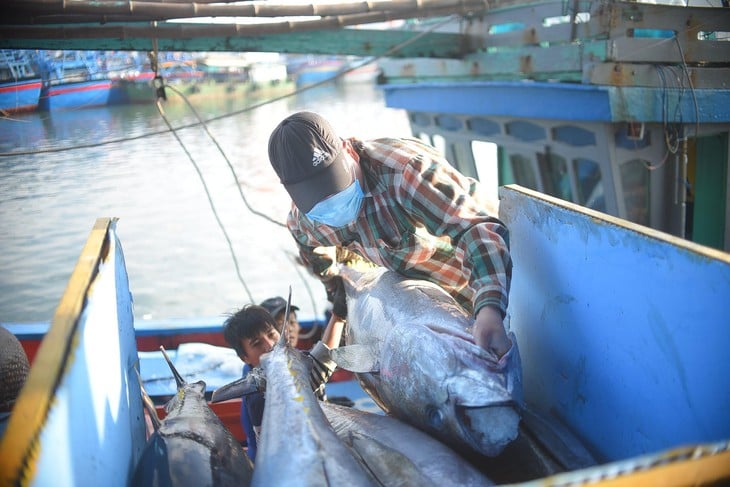
The US imposes taxes on countries, including Vietnamese shrimp and fish, which are also subject to very high reciprocal taxes - Photo: LAM THIEN
In the context of the US imposing tariffs on countries, in which Vietnam is subject to a reciprocal tax rate of 46%, among the highest among dozens of economies subject to reciprocal tariffs signed by Mr. Trump on April 2 (US time), export businesses are facing many major concerns.
Shrimp and fish are under many levels of pressure.
According to VASEP, in the first quarter of this year, shrimp of all kinds led with a turnover of more than 931 million USD, an increase of nearly 36%; tra fish contributed 465 million USD, an increase of 13%.
Explaining this growth, VASEP attributed it to strong demand in major markets such as China, the US, and the EU, where trade agreements such as the EVFTA are taking effect. In addition, stable raw material prices and a strategy to promote value-added products have helped these two items maintain their leading position.
Tuna, in particular, is considered a dark spot in the bright picture because it is the only product group with a decrease in turnover. In March, it only reached a turnover of over 83 million USD.
In the context of the US imposing taxes on countries, of which the US is a large market for Vietnamese seafood, businesses say this is an extremely big challenge.
"Vietnamese shrimp competes with Ecuadorian shrimp in the US and many other markets. Tuna exports to the US are now under two layers of pressure. That is the pressure from IUU regulations, in which the regulation on the minimum size of tuna of 0.5m has tightened the source of raw materials for export processing.
Then the US Marine Mammal Protection Act (MMPA) does not recognize equivalence for the Vietnamese seafood industry. If the requirements are not met, Vietnamese seafood will be banned from being imported into the US from January 1, 2026. This means that Vietnamese tuna is at risk of losing market share in the US, while also affecting other exploited products such as squid and octopus.
Now, the big barrier from increased tariffs is a "suffocating" challenge for Vietnam's seafood industry," said a VASEP leader.
US imposes taxes on other countries, Vietnamese businesses "panic, don't know what to do"
On April 3, speaking with Tuoi Tre Online , Mr. Ngo Minh Phuong, director of Viet Truong Company Limited ( Hai Phong ) said that the company exports seafood products to many markets, the US market accounts for about 20%.
"In April, there were orders to be delivered to partners, but the general reciprocal tax rate of 46%, calculated for shrimp from 0.1% to a new tax rate of 22.6%; frozen and processed fish from 1.5% to a new tax rate of 18.8% is too terrible. We are really panicking and do not know what to do," said Mr. Phuong.
Meanwhile, according to a business in Nha Trang City specializing in exporting shrimp to the US, the solution now is to stop exporting.
This person analyzed that previously, Vietnamese shrimp, fish, and seafood exported to the US had very low tax rates, and some items were not subject to import tax, so businesses were always looking for opportunities.
"But there were times when the US imposed an anti-dumping tax of more than 26%, at which time Vietnamese exporting enterprises immediately stopped and switched to new markets. For more than 20 years, the US has always been the largest market for Vietnamese seafood exports, despite anti-dumping and anti-subsidy lawsuits.
However, when the US imposed taxes on countries this time, including Vietnam, it left export businesses with no other option but to... withdraw," he said.
Finding export directions for Vietnamese seafood to new markets such as China, the EU, other European countries and continuing to wait for the Government's negotiations to balance the trade balance with the world's largest economy, reducing the pressure of being taxed by the US is the desire of the majority of businesses.
Source: https://tuoitre.vn/thuy-san-viet-nam-dung-ngo-khong-yen-khi-my-ap-thue-cac-nuoc-20250403113418915.htm


![[Photo] Readers line up to visit the photo exhibition and receive a special publication commemorating the 135th birthday of President Ho Chi Minh at Nhan Dan Newspaper](https://vphoto.vietnam.vn/thumb/1200x675/vietnam/resource/IMAGE/2025/5/17/85b3197fc6bd43e6a9ee4db15101005b)


![[Photo] Prime Minister Pham Minh Chinh chairs meeting on science and technology development](https://vphoto.vietnam.vn/thumb/1200x675/vietnam/resource/IMAGE/2025/5/17/ae80dd74c384439789b12013c738a045)

![[Photo] More than 17,000 candidates participate in the 2025 SPT Competency Assessment Test of Hanoi National University of Education](https://vphoto.vietnam.vn/thumb/1200x675/vietnam/resource/IMAGE/2025/5/17/e538d9a1636c407cbb211b314e6303fd)

















![[Photo] Nearly 3,000 students moved by stories about soldiers](https://vphoto.vietnam.vn/thumb/1200x675/vietnam/resource/IMAGE/2025/5/17/21da57c8241e42438b423eaa37215e0e)










































































Comment (0)